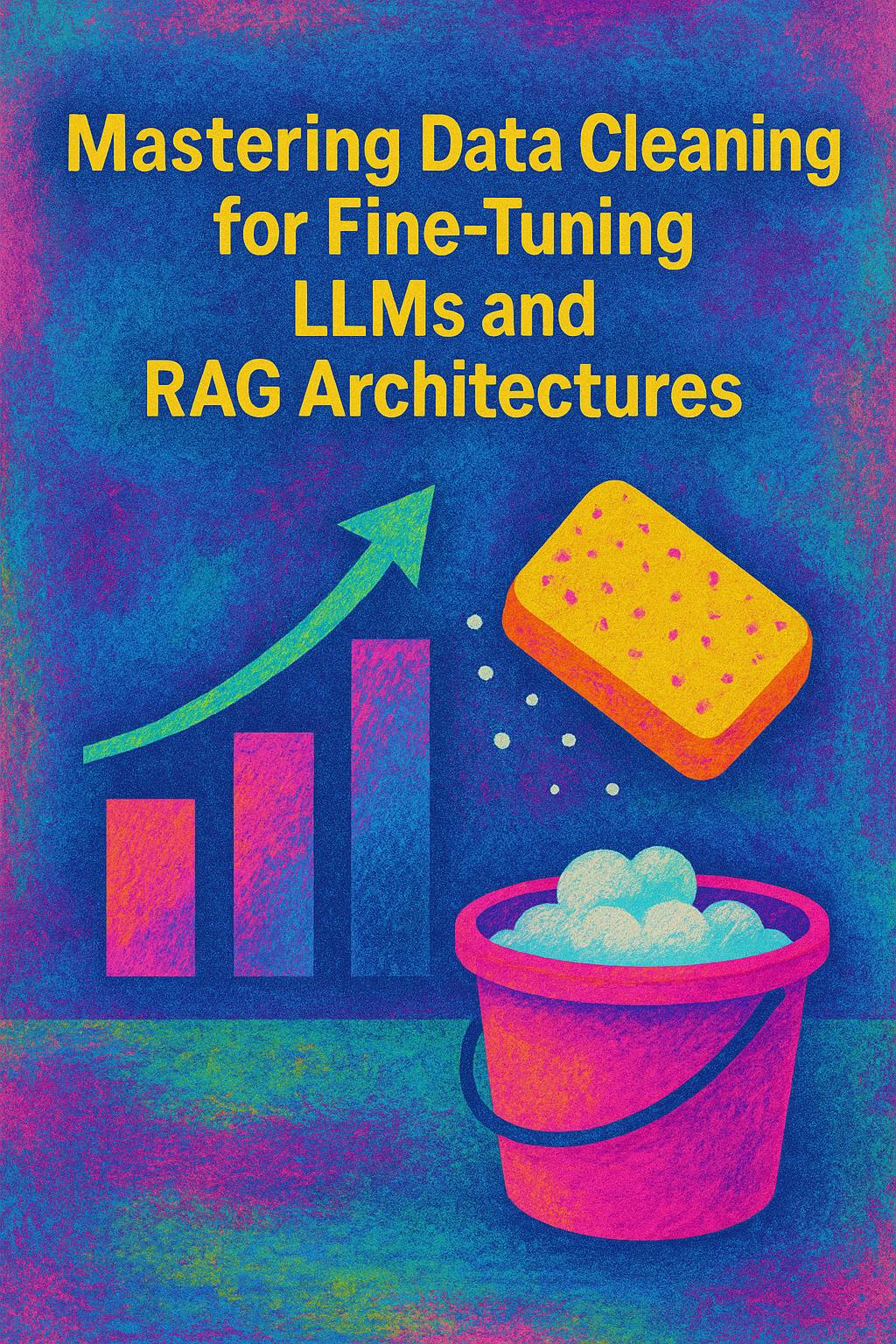Mastering Data Cleaning for Fine-Tuning LLMs and RAG Architectures
 Shahrokh Daijavad
Shahrokh Daijavad Dave Nielsen
Dave Nielsen Alireza Seddighi | Al Sedd
Alireza Seddighi | Al Sedd
Introduction
Data quality is paramount in AI, especially for advanced applications like fine-tuning Large Language Models (LLMs) and implementing Retrieval-Augmented Generation (RAG) architectures. These systems thrive on structured, high-quality datasets to generate accurate, contextually relevant outputs. Poor-quality data, on the other hand, can result in hallucinations in LLM outputs, irrelevant document retrievals, or even significant biases that erode trust in AI systems.
This blog dives deep into the critical role of data cleaning in AI workflows. You’ll explore essential techniques, innovative tools like IBM’s Data Prep Kit, and emerging trends reshaping AI data preparation. Whether you’re fine-tuning LLMs for niche applications or enhancing RAG systems for real-time information retrieval, mastering data cleaning is your key to success.
What Is Data Cleaning in AI Pipelines?
Data cleaning is a crucial step in preparing datasets for AI systems like LLMs and vector-based architectures. It involves identifying and addressing issues to ensure that data is accurate, consistent, and structured for optimal use. Key challenges addressed by data cleaning include:
● Harmful Data (Language, Code): Detects and removes toxic language or unsafe code to ensure datasets are ethical and safe for deployment.
● PII Removal: Protects sensitive information by identifying and anonymizing personally identifiable information (PII) to comply with regulations like GDPR and CCPA.
● Bias Mitigation: Identifies and reduces systemic biases to create fair and representative datasets, preventing skewed LLM outputs.
● Noise Elimination: Filters irrelevant, redundant, or misleading content to enhance the quality and relevance of embeddings.
For LLM fine-tuning, clean datasets enhance both generalization and domain-specific performance by ensuring models learn from high-quality data. In RAG architectures, clean data ensures that embeddings accurately reflect the content, improving retrieval precision and overall system performance.
What Are the Common Data Issues in AI?
High-quality data is the backbone of reliable AI systems like LLMs and RAG architectures. Without it, even state-of-the-art models can falter, leading to poor predictions, inefficiencies, and biased outcomes. Below, we explore the key challenges faced in AI data pipelines and how to address them effectively.
This flowchart provides a concise and structured overview of the most common data issues encountered in AI pipelines. It highlights the key challenges, their impacts on AI models, potential solutions, and tools commonly used to address them. The compact design combines related information into single nodes to enhance clarity and save space, making it an ideal reference for professionals navigating data preparation challenges.

Summary Table

How Data Cleaning Powers Preprocessing: A Comprehensive Breakdown
Data cleaning and preprocessing are inherently interconnected, with the success of preprocessing workflows hinging on clean, structured, and consistent data. This synergy is vital for building reliable and efficient AI models, as data cleaning establishes the foundation for preprocessing tasks to operate effectively. From feature engineering to bias mitigation, these interdependencies ensure data integrity, enhance downstream processes, and enable AI systems to achieve optimal performance. The table below details these interdependencies, supplemented by practical examples to highlight their real-world significance.

Data Cleaning Techniques for RAG, GraphRAG, and Fine-Tuning Workflows
The following table provides a comprehensive overview of key data cleaning techniques and their applications across three critical AI workflows: Retrieval-Augmented Generation (RAG), GraphRAG, and Fine-Tuning Large Language Models (LLMs). Each technique is detailed with its purpose, relevant tools, and specific use cases to highlight its importance in ensuring high-quality data pipelines. For instance, deduplication eliminates redundant entries to optimize vector databases for RAG, while handling bias ensures fair representations in both graph-based and fine-tuned models. The table also emphasizes practical examples, such as noise filtering for better graph traversal and embedding preparation for enhanced precision in retrieval tasks. This resource serves as a practical guide for practitioners aiming to optimize their AI systems by addressing common challenges like missing data, PII redaction, and outlier detection. Whether you're building robust vector databases, constructing logical knowledge graphs, or fine-tuning LLMs for advanced applications, these techniques provide the foundation for success.

Emerging Data Cleaning Methods: Advancing LLMs and RAG Architectures
Effective data cleaning is essential for optimizing LLMs, RAG systems, and GraphRAG architectures, ensuring the accuracy and reliability of AI workflows. Unlike traditional methods focused on static datasets and manual cleaning processes, these emerging techniques leverage AI-driven automation, real-time capabilities, and synthetic data generation to address modern challenges like streaming data, low-resource domains, and bias mitigation. The following table highlights these advanced methods, their applications, tools, and challenges, providing a practical guide for data preparation in cutting-edge AI systems.

Comparison of Data Cleaning Tools for Advanced AI Pipelines
In the fast-paced world of Artificial Intelligence, choosing the right data cleaning tool is key to building efficient pipelines. The following table clearly compares popular tools, analyzing their features, strengths, limitations, and more. From versatile open-source options like Pandas to enterprise-grade platforms like IBM Data Prep Kit, it highlights tools for every need and scale.
Table: Overview of Data Cleaning Tools for AI Pipelines

Comparing Data Cleaning Workflows: Fine-Tuning vs. RAG Retrieval
The comparison of data cleaning workflows for Fine-Tuning and Retrieval-Augmented Generation (RAG) highlights the distinct goals and methodologies tailored to specific AI applications. Both workflows start with raw input data, which undergoes targeted cleaning and preprocessing. In fine-tuning, the focus is on deduplication and normalization to ensure high-quality embeddings for effective model training. Conversely, the RAG workflow prioritizes noise removal and PII scrubbing to maintain privacy and optimize retrieval systems. By comparing these workflows side by side, we understand how data cleaning adapts to different use cases, enabling both accurate model fine-tuning and efficient retrieval systems for practical AI deployment.

Flowchart: Data Cleaning Workflows: Fine-Tuning vs. RAG Retrieval
Conclusion
Data cleaning is no longer just a preliminary step; it’s the foundation upon which successful AI workflows are built. For LLM fine-tuning, clean datasets enable better generalization and domain-specific learning, ensuring models deliver accurate and meaningful outputs. In RAG architectures, clean embeddings directly impact retrieval quality, making the difference between a seamless user experience and a frustrating one.
Practitioners can significantly enhance their AI systems' reliability and performance by leveraging advanced tools like IBM’s Data Prep Kit, integrating emerging trends such as real-time cleaning, and addressing challenges like bias and noise. Clean data doesn’t just improve metrics; it builds trust and ensures compliance, paving the way for scalable and ethical AI applications.
References:
1. IBM, “IBM Data Prep Kit Documentation” (https://github.com/data-prep-kit/data-prep-kit).
2. pandas development team, “Pandas Documentation” (https://pandas.pydata.org).
3. Scikit-learn developers, “Scikit-learn Documentation” (https://scikit-learn.org).
4. OpenRefine contributors, “OpenRefine” (https://openrefine.org).
5. Zhaohui Wang et al., “PyOD: A Python Toolbox for Scalable Outlier Detection” (https://pyod.readthedocs.io).
6. SeatGeek, “Fuzzywuzzy: Python Library for Fuzzy String Matching” (https://github.com/seatgeek/fuzzywuzzy).
7. Dedupe.io, “Dedupe Documentation” (https://dedupe.io).
8. TensorFlow Team, “TensorFlow Data Validation Documentation” (https://www.tensorflow.org/tfx/data_validation).
9. IBM, “AI Fairness 360 Toolkit Documentation” (https://github.com/IBM/ai-360-toolkit-explained).
10. Google Jigsaw, “Perspective API Documentation” (https://perspectiveapi.com).
11. AWS Labs, “Deequ Documentation” (https://github.com/awslabs/deequ).
12. Gretel AI, “Gretel Documentation” (https://gretel.ai).
13. KNIME, “KNIME Documentation” (https://www.knime.com).
14. RapidMiner, “RapidMiner Documentation” (https://rapidminer.com).
15. Helsinki-NLP, “OpusCleaner GitHub Repository” (https://github.com/Helsinki-NLP/OpusCleaner).
16. dbt Labs, “dbt (Data Build Tool) Documentation” (https://www.getdbt.com).
17. Apache Software Foundation, “Apache Spark Documentation” (https://spark.apache.org).
18. arXiv.org, “A Comprehensive Survey of Retrieval-Augmented Generation (RAG): Evolution, Current Landscape and Future Directions” (https://arxiv.org/abs/2410.12837).


